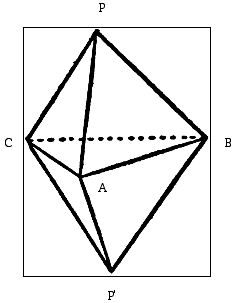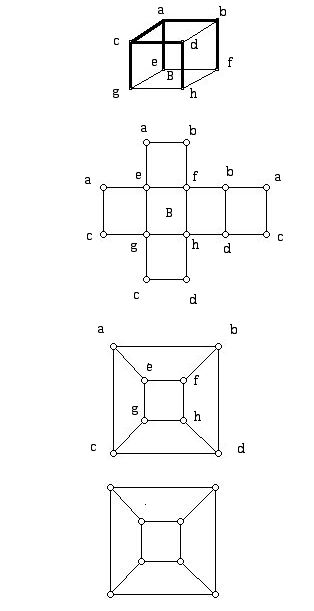
Figure 1
Sheet A: Problems Related to the Nets of a Bipyramid
Prepared by:
Joseph Malkevitch
Department of Mathematics and Computer Studies
York College (CUNY)
Jamaica, New York
email:
malkevitch@york.cuny.edu
web page:
http://york.cuny.edu/~malk
Figure 1 shows a convex polyhedron known as a bipyramid which has all of its faces equilateral triangles. This diagram is designed to show a three-dimensional object in 2-dimensions. The line CB is dotted to suggest that it is "hidden."

1. Count the number of vertices of the polyhedron in Figure 1.
2. Count the number of edges of the polyhedron in Figure 1.
3. Count the number of faces of the polyhedron in Figure 1. (Is ABC a face of this polyhedron?)
4. Do you see any relationship between the numbers you found for the number of vertices, edges, and faces?
Figure 2 shows a cube (at the top) with edges, which when cut (those are the bold edges) with scissors, will enable one to flatten out the cube (which is 3-dimensional) into a polygon which will lie flat (without faces overlapping) in the plane. We can see each of the six faces of the cube, and the labels correspond to the labels of the vertices in the original cube. A diagram such as this is often informally referred to as a "net" of the cube. In the top two parts of Figure 2 the face B on which the cube is sitting initially is singled out to be labelled. Does it surprise you that there are 10 other nets for the cube? Also shown is a different way to represent a cube in 2-D called a graph. All the vertices, edges, and faces appear in this diagram. However, one of the faces, which corresponds to the "top" of the cube, looks different from the others. It is shown as an unbounded region. Such a diagram, without the labels, is known as a graph. It consists of dots and line segments. Thus, in Figure 2 we see a sample of the kinds of ways that 3-D objects, in particular polyhedra, have been represented in 2-D.
4. For the bipyramid in Figure 1 draw as many different nets as you can. (Two nets (thought of as polygons as drawn in the plane) are considered different if you can not move one onto the other so that they coincide, perhaps turning over one of the nets to accomplish this. More formally, if the polygons that make up the nets are not congruent to each other, we will consider the two nets to be different. For each net you draw, list the edges that you have to cut (use labels in Figure 1) in order to flatten the bipyramid out into the plane.
